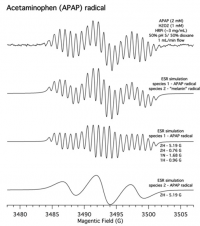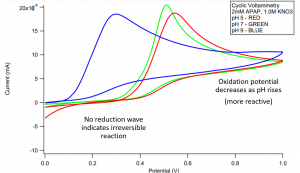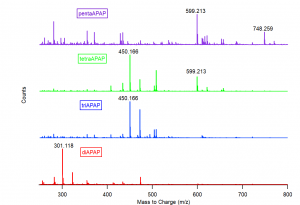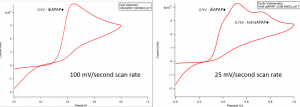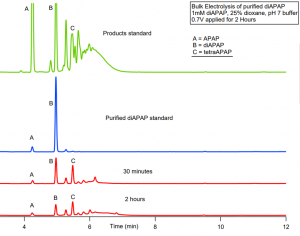Acetaminophen Induced Toxicity
An Alternative Mechanism of Acetaminophen Induced Hepatotoxicity
Matthew W. Simonson, Bradley E. Sturgeon
Monmouth College, Department of Chemistry
Abstract
Acetaminophen (APAP) is a common analgesic and an active ingredient in many painkillers such as Tylenol and Percocet. Upon overdose, APAP can lead to toxicity in the liver, which accounts for a striking proportion of acute liver failures in the United States annually. Considering the potential for APAP induced hepatotoxicity, our research group has analyzed APAP and its tendency to oxidize into reactive metabolites through enzymatic methods of in vitro oxidation, which was visualized through HPLC pairing with a diode array detector. Characterization of these APAP oxidation products were carried out using electron spin resonance (ESR), electrospray ionization tandem mass spectrometry (ESI-MS/MS), and 400 MHz proton nuclear magnetic resonance (H-NMR). Our findings provide structural and mechanistic insight into the radical propagation of potentially deleterious APAP metabolites formed in the liver during times of APAP overdose.
Introduction
- Acetaminophen (Paracetamol, 4'-Hydroxyacetanilide, 4-Acetamidophenol, or APAP) is one of the most widely used analgesics and antipyretics and can be purchased over the counter. Moreover, APAP overdose remains to be a large problem in the United States and is responsible for a majority of acute liver failures annually (1,2). The quantitative difference between a safe dose and a toxic dose is narrow, and varies by individual based on environmental, genetic, and metabolic factors. Hence, it is deceptively easy to take too much APAP and cause a trip to the emergency room, permanent liver damage, or even death.
- While APAP itself is harmless, APAP metabolic pathways have been investigated by numerous studies which allude to the reactive metabolites of APAP being responsible for liver necrosis. The formation of reactive metabolites coupled with glutathione depletion and alkylation of mitochondrial proteins are suggested to be the critical initiating events for APAP induced hepatotoxicity by way of causing mitochondrial permeability transition (MPT), which is an increase in permeability of the inner membrane that may lead to apoptosis or necrosis of liver cells (3). Reactive metabolites of APAP form via oxidation of APAP in the liver, which occurs after other nontoxic metabolic pathways such as glucuronidation and sulfation have been saturated.
- APAP may undergo a one electron oxidation to yield the APAP phenoxyl radical (N-acetyl-p-benzosemiquinone imine; NAPSQI) or a direct two electron oxidation to produce N-acetyl-p-benzoquinone imine (NAPQI) via Cytochrome P450 enzymes (CYPs) (4). The result leads to hepatotoxicity after intracellular supplies of glutathione have been used up. The commonly accepted mechanism of oxidative metabolite formation during APAP overdose revolves around the direct two electron oxidation of APAP into NAPQI (5, 6). NAPQI is then purported to be reduced and detoxified via glutathione (GSH) conjugation through glutathione transferase, leading to cysteine and mercapturic acid metabolites to be formed (7). The formation of NAPQI has been indirectly identified as a metabolite of APAP oxidation within the liver through its conjugation with glutathione (6). The uncertainty associated with this indirect metabolic identification raises hesitance to NAPQI being the only actor during APAP overdose. Moreover, the oxidation of APAP by one electron to form NAPSQI may be independently reduced by GSH, reforming APAP and forming glutathione disulfide (GSSG) (8). Under scenarios of depleted glutathione reserves, this pathway may yield a different set of metabolites, which could play bioactive roles responsible for the MPT and resulting hepatotoxicity observed following APAP overdose.
- Possible metabolites associated with a one electron oxidation of APAP in the liver have been identified using model systems such as enzymatic or electrochemical methods of oxidation in place of liver microsomes. Following a one electron oxidation by a model enzyme, Horseradish peroxidase (HRP), studies have been done to characterize the APAP radical intermediate in solution through electron spin resonance (ESR) and the potential for this radical to from a different set of metabolites that are not NAPQI (9,10). Characterization of the postulated metabolites allowed for the identification of a set of APAP polymers consistent with a mechanism of radical polymerization (11). Deeper investigation into such metabolites and their radical intermediates could shed light on the controversial topic of how APAP induced liver necrosis disseminates. Considering that, the purpose of this work is to revisit the oxidation of APAP and its downstream oxidation products in order to elucidate a better understanding of the chemistry occurring during this reaction.
Materials and Methods
Horseradish Peroxidase Type II (HRP) was in order to mimic the proposed one electron oxidation of Acetaminophen (APAP) by the liver through Cytochrome P450s in beaker based conditions. The enzyme was stored at -20 degrees Celsius. All chemicals were purchased from Sigma Aldridge unless otherwise stated.
High Performance Liquid Chromatography
Analysis by reverse phase high pressure liquid chromatography (HPLC) was carried out with a C18 column and paired with a UV-Vis spectroscopy as a detector at 270 nm. Analyses were ran for eighteen minutes with a mobile phase beginning at 100 percent acidized water to 100 percent (30% volume to volume) acetonitrile.
Figure 4 data was collected with a 2 mM APAP standard and subsequent reactions involving 2 mM APAP, 9 nM HRP, and increasing H2O2 concentration gradient (0.25 mM, 0.50 mM, 1 mM, and 2mM). This was done in a pH 5, type 1 water, phosphate-citrate buffer solution.
Additionally, reactions were also ran and analyzed with 50mM APAP, 12.5mM H2O2, and 9nM HRP in a 50% Dioxane - Phosphate citrate buffer (pH 5.0) solution to elucidate products that fell out of solution in hydrophilic conditions.
Bulk Electrolysis
Bulk electrolysis was carried out in an organic cell with a platinum working electrode and a nanocarbon mesh counter electrode with a silver chloride reference electrode. This solution was then subjected to 0.7 V for 40 hours in order to oxidize APAP for analysis via reverse phase HPLC. The electrosynthesized oxidation products were then freeze dried via Freezone instrument until only solid remained and then vacuum filtrated with methanol to remove the methanol soluble oxidation products from the methanol insoluble salts. The methanol solubilized product was then vacuum distilled using a freeze trap with ice to pull off the solvent until 1-2 mL remained. The sample was then loaded onto the Flash Chromatography system to be purified.
Flash Chromatography
Flash chromatography was utilized to isolate the Acetaminophen oxidation products. A smooth gradient of 100% Formic acid (0.1% potency) held constant for three minutes to 70% acetonitrile over the course of 20 column volumes was ran in order to accomplish this. A 150 g gold C18 column was used for these separations. Purified oxidation products were then freeze dried via a Freezone instrument at
Liquid Chromatography Mass Spectrometry
Quadrople Time of Flight LC-MS was used to analyze the suspect dimer and suspect tetramer that were isolated via flash chromatography. This was done at Western Illinois University.
Proton Nuclear Magnetic Resonance
Cyclic Voltammetry
Using a thin electrode, cyclic voltammetry was carried out to identify the oxidation potentials of APAP at different pHs. Three 2 mM APAP, 1.0 M KNO3 solutions were prepared for this at pH 5, pH 7, and pH 9. The resulting voltammograms are presented in Figure ...
Electron Spin Resonance
An immobilization of HRP was completed using Affi-Gel® 10. This procedure was centered around the isoelectric point of the enzyme. The immobilization was completed using a MOPS buffer (pH 7.0) and about 1 mL of Affi-Gel® beads. The immobilized HRP was further introduced into a flat cell at about 75% of the flat cell's total height for the detection of radical intermediates using ESR.
A 2 mM APAP and 1 mM H2O2 in 50% Dioxane-Phosphate citrate buffer (pH 5.0) solution was ran through the flat cell. The spectra was gathered using the following instrument conditions: center field at 3487 Gauss, sweep rate of 40 Gauss/second, microwave power of 20 mW, and a modulation amplitude of 1.0 Gauss. The resulting ESR spectra (Figure 1) was modelled using WINSIM computer software.
Results and Discussion
Electron Spin Resonance (ESR) experiments indicate the existence of an APAP radical intermediate observable in the HRP mediated reaction. A simulation of this experimental spectrum gave hyperfine coupling values associated with a lone electron being present at the phenoxy, ortho, para, and amide position on the APAP molecule. The associated hyperfine coupling values were determined to be 5.19 Gauss for the ortho protons,
Background noise was separated out from the APAP radical spectrum, which was referred to as species 2 or melanin. This species had to have hyperfine coupling associated with it in order to simulate experimental data. Considering the reactive nature of this reaction, the background noise is purported to be the radical intermediate of further polymerized APAP.
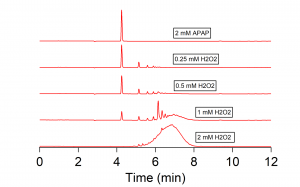
Utilizing HRP as a model enzyme for CYPs' oxidation of APAP in the liver indicates the formation of increasingly nonpolar APAP conjugates in the form of polymers.
References
1. Lee, W. M. (2013) File:Lee; Drug Induced Liver Failure.pdf. Clin Liver Dis. 17. 575-586.
2. Bernal, W., Lee, W. M., Wendon, J., Larsen, F. S., and Williams, R. (2015) Acute liver failure: A curable disease by 2024?. J. Hepatol. 62. 112-120.
3. Hinson, J. A., Reid, A. B., McCullough, S. S., & James, L. P. (2004). Acetaminophen‐Induced Hepatotoxicity: Role of Metabolic Activation, Reactive Oxygen/Nitrogen Species, and Mitochondrial Permeability Transition. Drug Metabolism Reviews, 36(3-4), 805–822.
4. Potter DW, Hinson JA. Mechanisms of acetaminophen oxidation to N-acetyl-P-benzoquinone imine by horseradish peroxidase and cytochrome P-450. J Biol Chem. 1987;262:966–973.
5. Gillette JR, Nelson SD, Mulder GJ, Jollow DJ, Mitchell JR, Pohl LR, Hinson JA. Formation of chemically reactive metabolites of phenacetin and acetaminophen. Adv Exp Med Biol. 1981;136(Pt B):931–950.
6. Dahlin, D. C., Miwa, G. T., Lu, A. Y., and Nelson, S. D. (1984) N-acetyl-p-benzoquinone imine: a cytochrome P-450-mediated oxidation product of acetaminophen. Proc. Natl. Acad. Sci. U. S. A. 81, 1327-1331.
7. David Ross, Kajsa Norbeck, and Peter Moldeus. (1985) The Generation and Subsequent Fate of Glutathionyl Radicals in Biological Systems. Journal of Biological Chemistry. Vol 260(28) 15028-15032.
8. West P. R. Harman L. S. Josephy P. D. and Mason R. P.(1984) Acetaminophen: enzymatic formation of a transient phenoxyl free radical. Journal of Biochemical Pharmacology. Vol 33(18) 2933-2936.
9. Volker Fischer, Paul R. West, Laura S. Harman, and Ronald P. Mason. (1985) Free-Radical Metabolites of Acetaminophenand a Dimethylated Derivative. Environmental Health Perspectives Vol 64 127-137.
10. Potter, D. W., Miller, D. W., and Hinson, J. A. (1985) Identification of acetaminophen polymerization products catalyzed by horseradish peroxidase. J. Biol. Chem. 260. 12,174-12,180.
1. Potter, DW; Miller, DW; Hinson, JA. Identification of acetaminophen polymerization products catalyzed by horseradish peroxidase. Journal of Biological Chemistry, 260,22 (1985). 12174-2180. Print
2. Dahlin, DC; Miwa, GT; Lu, AYH; Nelson, SD. N-acetyl-p-benzoquinone imine: a cytochrome P-450-mediated oxidation product of acetaminophen. Journal of Biochemistry, 81 (1984). 1327-1331. Print
3. West, PR; Harman, LS; Josephy, PD; Mason, RP. Acetaminophen: enzymatic formation of a transient phenoxyl free radical. Biochemical Pharmacology, 33(18) (1984) 2933-2936. Print
